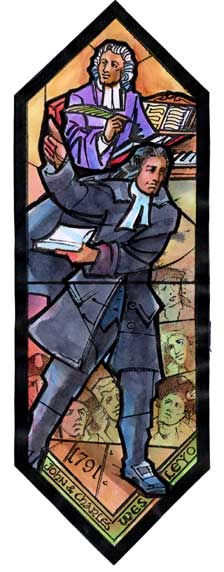|
|
|||

|
|||
Wesley Brothers Window
 During the 17th and 18th centuries, dogma and rigidity slowly replaced the zeal and creativity of the early Reformers; and philosophers replaced the idea of divine revelation with a universal rational morality, casting doubt on traditional Christianity. These changes left the Church particularly unprepared to meet the challenges of the Industrial Revolution at the end of the 18th century. As a response, some (including the Moravians) called for a return to Scripture in a spirit of devotion and piety. John and Charles were the 15th and 18th children, respectively, of the Reverend Samuel and Susanna Wesley. Both were educated at Oxford, and were part of a prayer group derisively called the “methodists,” because of their strict method of piety. Both were ordained in the Church of England and served for a time in the American colonies. On the ship to Georgia, John was impressed by a group of Moravians, and when the brothers arrived back in London, both (separately) went to a Moravian meeting and experienced “an inner conversion” which changed their lives and ministries. When they found the churches closed to their message, they became itinerant preachers. John reached the masses with his appeal for a personal commitment to Jesus Christ. Even in winter, 2,000 to 3,000 miners would gather in the open air to listen for two hours to John’s message of holiness and hope in Christ. To provide for the spiritual needs of so many, John organized classes and trained lay-preachers, including women. John saw these classes as complementing regular church attendance, and never scheduled his preaching in conflict with a service. In 52 years of preaching, he covered 225,000 miles on horseback, preached 40,000 sermons, and wrote 32 volumes. Charles also traveled for 17 years, and acted as John’s interpreter and defender to his critics; but he is famous for his beautiful hymns: “Jesu, Lover of My Soul,” “Love Divine All Loves Excelling,” “Hark the Herald Angels Sing,” and 6,000 others—over 20 are in the 1982 Hymnal. Though the Methodist Church in the United States was begun by John, he and Charles loved the Church of England and were faithful to the end. Together they led the great revival of the 18th century, and still touch the lives of many today. The Wesleys bring music to our windows. John is shown preaching; Charles, composing at a keyboard. The faces are the masses, listening and singing.
Like Stars Appearing: The Story of the Stained Glass
Windows of St. George's Episcopal Church, Dayton, Ohio | |||
|
|||
